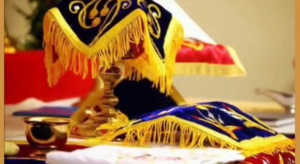Holy Qurbana at a Glance

I. PRECOMMUNION SERVICE – (30 years of our LORD’s Life)
Sanctuary remains veiled – The period before the Incarnation of Christ.
- Prefatory Prayers – Morning Prayers (Namasakaram)
- Entrance into Chancel
Sanctuary unveiled Celebrant enters – South side – Sanctuary veiled.
Shubkono1, Washing of hands1
- Thuyobo – Preparatory Rites – Celebrant
Service of Melchizedek – Arranges bread and wine
Service of Aaron – Vesting by the celebrant
- Old Testament Readings
- Final Hymns before Holy Qurbana
II. Communion Service (3½ years of our lord’s life)
Pre–Anaphora (Liturgy of the Word). We remember the Birth, Baptism, Teaching and Healing Ministry of Christ.
First unveiling of the Sanctuary – Incarnation of the Promised Messiah Christ.
- Procession of the Incarnate Word
- Trisagion (Adoration to Christ)
- New Testament Readings: North (Acts or Catholic Epistle) / South (Pauline Epistles)
- 1st Slomo
- Reading from the Holy Gospel by the Chief Celebrant
- 2nd Slomo
- Sermon (can be postponed for the convenience sake, till Kukkillion)
- Prelude to the ministries of the Holy Sacrament
- Prayers of Promeon, Hussoyo and Sedro.
- Blessing of the censor – Adoration of the Holy Trinity
Nicene Creed, Incensing – Shubkono2, Washing of hands2
- Intercessory Prayers, at the foot of the altar, by the Chief Celebrant.
Anaphora of the Faithful
Stage I Act I – We remember opening of Heaven and God’s Presence.
- Priests ascends the Altar step
- 3rd Slomo
- Kiss of peace
- First Inclination
- Celebration of Soshappa
First Benediction (Apostolic)
Stage I Act II
- Sarsum Corda – Lift Ye Up
- Tersanctus
- Institution of Holy Qurbana
- Anamnesis – Sacrificial Memorial
- Epiclesis – Invocation of the Holy Spirit
- Consecration – Consecrating the Bread and Wine
Stage I Act III
- The Great Intercession – Thubden / Diptychs
- 4th Slomo
- Second Benediction (In the Name of Christ)
- First veiling of the Sanctuary – Crucifixion of Christ.
Stage II ACT I – We remember Passion, Death and Resurrection of Christ
- Fraction, Consignation, Commixture by Chief Celebrant
- Catholic Hymn / Catholic Litany
Stage II ACT II – We remember Ascension of our Lord
- Second Unveiling of Sanctuary – Appearance of Christ to His disciples after Resurrection
- Lord’s Prayer
- 5th Slomo
- Second Inclination
- 6th Slomo
- Third Benediction (In the name of the Holy Trinity)
- Elevation of Holy Mysteries – Ascension of our Lord
Stage II ACT III – Intercessory Prayers
- Kukkillion – Communion of Mother of God, Patron Saints and other Saints. Commemoration of the Departed – Clergy, Faithful Believers.
- Shubkono3
- Second Veiling of the Sanctuary – Christ’s hidden to our bodily eyes after Ascension
- Communion of the Holy Mysteries
- Third Unveiling of the Sanctuary – Opening of Heaven / Second Coming of Christ.
- Procession of Holy Mysteries – Second Coming of our Lord.
STAGE II ACT IV
- Final Thanksgiving
- 7th Slomo
- Third Inclination
- Dismissal
- Final Veiling of Sanctuary – End of the public part of the service.
III. POST COMMUNION SERVICE
- Closing Prayers
- The Celebrant consumes the Sacred Elements
- Cleans the Holy Vessels, Washing of hands3
- Bids farewell to Altar
- Kaimuth and Free Will Offering
2 Comments
T. Alex John · September 19, 2022 at 6:07 pm
As You have shared this link in OCN B2L1, I read this piece of information. Thank you, sir, for this. Now my certain query: (1) What is the etymology of the word “Qurbana” with various root words and connotations. I think, it is definitely is ancient syric word. There is a similar word used in urdu, hindi and arabi and farsi, i.e. क़ुरबानी / बलि which conveys the meaning of sacrifice implying that something is offered on the alter mostly as blood sacrifice/even bloodless in order to obtain something. Once I get the answer to this, I may like to ask further.
Jacob P Varghese · September 21, 2022 at 2:10 am
Dear Sir,
The Etymology of the word is from Syriac word Qurbono or Qurbana, which means – offering, gift, dedication, offering of sacrifice, sacrifice. Sacrifice of our Lord for the forgiveness of our sins. OT law required sacrifice for atonement of sins. The blood of the Passover Lamb saved the first born of Israel from physical death, saved Israelites from bondage. His blood saves us from spiritual death and bondage from sin. We are to offer ourselves completely to God as a burnt offering where nothing was set aside.
Holy Qurbana is a sacrifice of the whole Church for the whole world, that which is offered to God. Through the sacrifice of our Lord, we offer ourselves and the whole universe as a sacrifice to the heavenly Father.